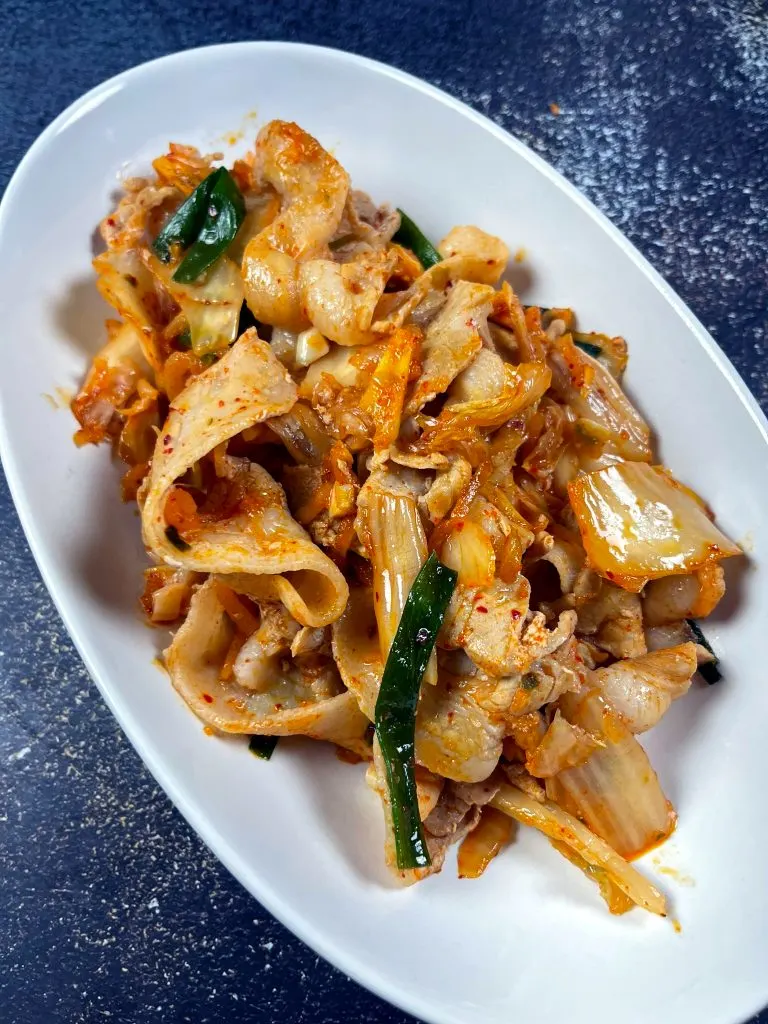Kimchi Pork Belly Stir Fry is a flavorful dish that combines pork belly with fermented kimchi, garlic, ginger, and green onions! Perfectly delicious served with some fluffy white rice.
What is Kimchi?
Kimchi is salted and fermented veggies, most common veggie being napa cabbage, originating from Korean cuisine. But other veggies such as Korean radish can be used too.
Seasonings such as gochugaru (Korean chili flakes), spring onions, garlic, ginger can be used to make Kimchi.
Kimchi’s flavor is one that I love – due to the fermentation process, it is sour, spicy, and savory flavor.

Not only is it tasty, but it’s also nutritious! It’s got fiber, various vitamins, minerals, and as it is fermented, it contains probiotics also, which is great for gut health.
While kimchi is often eaten as a side dish, it can also be used as an ingredient in cooking, such as in soups, stews, pancakes, and stir fries such as this one!
Where Does Pork Belly Come From?
Pork Belly, like bacon, is a boneless cut from the underside or the belly of the pig, after the loin and the spareribs have been removed. It is not the stomach but actually the flesh part.
This cut of meat has a rich, fatty flavor and a chewy texture and can be used in a variety of dishes. It is a popular ingredient in Asian cuisine, and it’s also often used in Western dishes too – such as pork belly confit and pork belly burnt ends.
Pork belly is a good source of protein, B vitamins, and minerals. It is also a good source of monounsaturated and polyunsaturated fats, which are healthy fats. However, pork belly is also high in saturated fat and cholesterol so it is important to eat pork belly in moderation.
What is the difference between Pork Belly and Bacon? Pork belly is basically the uncured, unsmoked and uncut bacon. Or I should say you make bacon from pork belly. Once you pork belly is cured, smoked and sliced, it is officially called bacon.

Where to buy Pork Belly?
There are a few options on where you can buy pork belly:
- Grocery stores: Many grocery stores carry pork belly, either fresh or frozen.
- Butcher shops: Butcher shops are a good source for high-quality pork belly. So if your local grocery stores don’t have it google search for some butcher shops near you.
- Asian markets: Asian markets often carry pork belly, as it is a popular ingredient in Asian cuisine. This is where I get my pork belly from!
- Online retailers: There are a number of online retailers that sell pork belly such as Crowd Cow where they ship to anywhere in the US other than Alaska and Hawaii sustainable and healthy meats/seafood!
When purchasing pork belly, it is important to choose a cut that is fresh and has a good color. The skin should be firm and not have any bruises or blemishes. The meat should be firm and not have any gray or green discoloration.
Pork belly can be stored in the refrigerator for up to 3 days or in the freezer for up to 6 months.
If you love pork belly – check out my other pork belly dishes:
- Chinese Red Braised Pork Belly (Hong Shao Rou)
- Pan Fried Pork Belly
- Red Braised Pork Belly with Bamboo Shoots
- Twice Cook Pork Recipe 回鍋肉

How to cook Kimchi Pork Belly Stir Fry
First gather your ingredients:
- 1/2 lb pork belly, sliced thinly
- 4 cloves of garlic, roughly chopped
- 1/2 tbsp ginger, sliced thinly
- 1½ cup kimchi
- 1-2 tbsp kimchi juice (optional)
- 3 green onions, cup to 2 inch length
- 1 tsp sesame oil
In a wok or pan, without adding any oil, add pork belly and stir fry until mostly browned. The pork belly will produce grease on its own so you do not need to add extra oil.


Add garlic and ginger and stir fry for about a minute.


Add the kimchi and stir everything together. Add in the kimchi juice if you choose to. Stir to combine well.


Add green onions and sesame oil, and stir fry until cooked thoroughly.


Remove from heat and serve!



Kimchi Pork Belly Stir Fry

Kimchi Pork Belly Stir Fry is a flavorful dish that combines pork belly with fermented kimchi, garlic, ginger, and green onions! Perfectly delicious served with some fluffy white rice.
Ingredients
- 1/2 lb pork belly, sliced thinly
- 4 cloves of garlic, roughly chopped
- 1/2 tbsp ginger, sliced thinly
- 1½ cup kimchi
- 1-2 tbsp kimchi juice (optional)
- 3 green onions, cup to 2 inch length
- 1 tsp sesame oil
Instructions
- In a wok or pan, without adding any oil, add pork belly and stir fry until mostly browned. The pork belly will produce grease on its own so you do not need to add extra oil.
- Add garlic and ginger and stir fry for about a minute.
- Add the kimchi and stir everything together. Add in the kimchi juice if you choose to. Stir to combine well.
- Add green onions and sesame oil, and stir fry until cooked thoroughly.
- Remove from heat and serve!
Notes
Customization ideas: Feel free to add 1-2 tbsp of gochujang and/or 1-2 korean red pepper flakes for even more flavor!
Recommended Products
As an Amazon Associate and member of other affiliate programs, I earn from qualifying purchases.
-
 Santoku Knife - imarku 7 inch Kitchen Knife Ultra Sharp Asian Knife Japanese Chef Knife - German HC Stainless Steel 7Cr17Mov - Ergonomic Pakkawood Handle, Best Choice for Home Kitchen and Restaurant
Santoku Knife - imarku 7 inch Kitchen Knife Ultra Sharp Asian Knife Japanese Chef Knife - German HC Stainless Steel 7Cr17Mov - Ergonomic Pakkawood Handle, Best Choice for Home Kitchen and Restaurant -
 Hiware 10-Pairs Fiberglass Chopsticks - Reusable Chopsticks Dishwasher Safe, 9 1/2 Inches - Black
Hiware 10-Pairs Fiberglass Chopsticks - Reusable Chopsticks Dishwasher Safe, 9 1/2 Inches - Black -
 Eleulife Wok Pan with Lid, 13 Inch Carbon Steel Wok with Spatula, Nonstick Woks and Stir-fry Pans, No Chemical Coated Flat Bottom Chinese Wok for Induction, Electric, Gas Stove, All Stoves
Eleulife Wok Pan with Lid, 13 Inch Carbon Steel Wok with Spatula, Nonstick Woks and Stir-fry Pans, No Chemical Coated Flat Bottom Chinese Wok for Induction, Electric, Gas Stove, All Stoves -
 Kadoya Sesame Oil, 22.10 Fluid Ounce
Kadoya Sesame Oil, 22.10 Fluid Ounce -
 JONGGA Spicy Napa Cabbage Kimchi (Pack of 8), Shelf Stable Mat Kimchi, Spicy Korean Authentic Fermented Pickled Cabbaged Kimchi, Perfect with Ramen, Noodles and Rice
JONGGA Spicy Napa Cabbage Kimchi (Pack of 8), Shelf Stable Mat Kimchi, Spicy Korean Authentic Fermented Pickled Cabbaged Kimchi, Perfect with Ramen, Noodles and Rice
Nutrition Information:
Yield:
2Serving Size:
1Amount Per Serving: Calories: 497Total Fat: 28gSaturated Fat: 9gTrans Fat: 0gUnsaturated Fat: 17gCholesterol: 95mgSodium: 822mgCarbohydrates: 33gFiber: 7gSugar: 19gProtein: 31g
The nutrition information for this recipe is an approximate total per serving. Please double check the nutrition information for your exact ingredients and brands for more precise nutrition information. Keep in mind that if there is a marinade, often times not all the ingredients will be consumed.
Pin for later!


